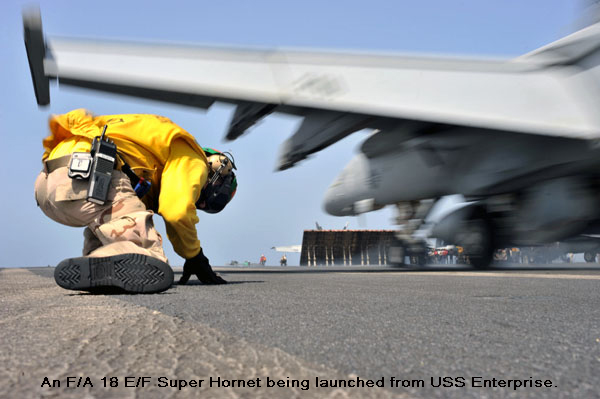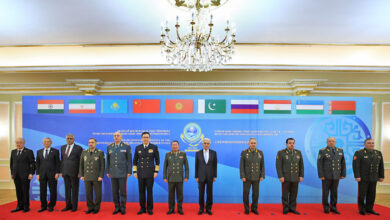US deployed three aircraft carriers to support Operation Neptune Spear
New Delhi. The US Navy deployed an unprecedented three aircraft carriers to support Operation Geronimo, and gave very strong air cover to the SEAL commandos who hunted down Osama bin Laden in Pakistan’s garrison city of Abbotabad.

An analysis of the operation, the deployment pattern, and the possibilities of a clash with Pakistani forces clearly indicate that at least two squadrons of US Navy’s sophisticated F/A 18 E/F Super Hornets, several AH 64 Apaches, one or two EA 18 G Electronic Attack Growlers, two aerial refuellers and one E-8C Joint Surveillance Target Attack Radar System (J-STARS) combat management aircraft would have been airborne to engage any aircraft that interfered with the mission. It is not known from which carrier the attack aircraft would have taken off but two of the carriers, USS Carl Vinson (CVN 70) and USS Enterprise (CVN 65), were deployed right in the Arabian Sea and the third, USS Ronald Reagan (CVN 76), not far away at another point in the Indian Ocean.

Two aircraft carriers have some times been deployed, and also often overlap while changing duties. But the presence of a third one in the vicinity would be unusual and called for only in case of possible eruption of hostilities. Carl Vinson is reported to be moving out of the region now, and the US Navy’s newest and most modern nuclear-capable aircraft carrier, USS George H W Bush (CVN 77) has just left its homeport at Norfolk, Virginia for the Arabian Sea for its first deployment.
Incidentally, in an unrelated but milestone development, USS George H W Bush is commanded by a lady officer, Rear Admiral Nora Tyson. It is the first time that a woman is heading a carrier strike task force, and the event also marks the centenary of US naval aviation.
As for Operation Geronimo, it can safely be assumed though that the Pakistani Air Force (PAF) would have been warned off if its aircraft had taken to the skies, and there would have been no clash.
Nonetheless, as reports emanating from Washington DC indicate that should the Pakistanis –or somebody else – would have interfered, then the US was ready to risk a military confrontation.
The New York Times, which revealed new details of the operation quoting an Administration official, says: “Their instructions were to avoid any confrontation if at all possible. But if they had to return fire to get out, they were authorized to do it.”

As per the Standard Operating Procedures (SOPs), the commandos would have had heavy air cover and electronic warfare support to execute the mission and to return to their base in Afghanistan safely. There would also have been some more SEAL and other commando teams as well as special operations troops on standby, to take action if any unlikely ground battle erupted.
The US government treats the survival of its military officers and men with utmost importance, and there are numerous incidents since the Vietnam War in which the US forces undertook daring Combat Search and Rescue (CSAR) missions to extricate pilots and war fighters from troubled areas. It is a safe assumption that at least six Boeing
CH 47 Chinooks, which can carry around 40 persons each, would have been ready for CSAR, a role for which this helicopter was once chosen by the US Air Force. (There are no orders yet).
According to indications and published reports, four helicopters took part in the raid on Osama bin Laden’s million dollar safe-house: two CH 47s and two specially configured MH 60Rs. Both the helicopters, as well as the Apaches, have advanced night fighting and operational capabilities and fly at matching speeds of over 150 knots/hour.
An MH 60R can carry only about a dozen troops, and if the number of commandos involved in the operation was 79 as stated by reports from the US capital, then only the Chinooks would have ferried most of them.
The Belgian Shepherd or Malinois breed dog that the SEAL Team Six had with it to sniff explosives and attack terrorists reportedly with implanted titanium teeth would have been in the MH 60R, which these commandos would have flown at treetop heights, guided by their own night vision sensors and assistance from the JSTARS and satellites.

As a standard drill, SEALs always fly below 500 feet, but for a mission like this, treetop hovering would be mandatory to evade radars.
The MH 60R uses the hull of Sikorsky’s Black Hawk, but is equipped from toe-to-tail by Lockheed Martin, whose technology innovation arm Skunk Works possibly fitted some additional noise reduction systems on them.
There are some reports saying that it was a new type of stealth helicopter that the SEALs used. But this writer’s interaction with military technology experts indicates that whatever it was, the platform was that of the MH 60R, the standard and most advanced naval helicopter that the SEALs now use.
A variant of this helicopter incidentally was offered by the US Navy recently for sale to the Indian Navy but was not accepted perhaps because of procedural FMS issues.
According to Boeing, which recently developed the Growler using the Super Hornet platform, the aircraft incorporates “advanced Airborne Electronic Attack (AEA) avionics bringing transformational capability for suppression of enemy air defenses (SEAD) and non-traditional electronic attack operations.”
Growler was deployed for the first time in October 2010, in Iraq initially and then over Afghanistan. It is armed with Raytheon’s highly advanced electronic warfare and radar jamming systems, and is capable of fighting out of a mission if attacked. Admittedly, some of the best anti-radar weapons like the Raytheon’s AGM-88 supersonic
High Speed Anti Radiation Missile (HARM) are available only with and from the US.
The JSTARS is built on remanufactured Boeing 707 platforms, and according to the US Air Force (USAF), it is the only system in the world capable of real time surveillance over a large, corps-sized area of a battlefield.

It can track the movement of small vehicles, and relay communications between an operating unit like the SEALs and a command centre anywhere in the world. Notably, real time pictures of the operation were relayed to the Pentagon and CIA as well as the White House Situation Room in Washington for the benefit of the commanders and the US President.
That was likely done through JSTARS, which has an approximately 8-metre long electronic phased array radar and secure satellite connectivity.
All the SEAL and other commandos can now be equipped with helmet-mounted cameras, as standard equipment if required, and pictures taken by them would have been tranmitted to operational commanders and the President in Washington through the JSTARS.
The aircraft is often deployed to control aerial strike by unmanned aircraft (or drones) like the Global Hawk, which the US has continued after the elimination of Osama bin Laden, and despite publicly aired warnings and requests by Pakistan to stop them.
Built by military technology giant Northrop Grumman, JSTARS was first deployed in Operation Desert Storm in 1991 against Iraq after its occupation of Kuwait. But the version flying today has revolutionary capabilities compared to what were available 20 years ago.
According to the US Air Force, JSTARS uses a multi-mode side looking radar to “detect, track, and classify moving ground vehicles in all conditions deep behind enemy lines” and that “the radar and computer subsystems on
the E-8C can gather and display detailed battlefield information on ground forces. The information is relayed in near-real time to the Army and Marine Corps common ground stations and to other ground command, control, communications, computers and intelligence, or C4I, nodes.”
Apparently, the aircraft would have kept a close watch on the movement around the Osama bin Laden safe house, which was otherwise “safely” located in between the Baloch Regimental Centre and the prestigious Pakistan Military Academy in the green and peaceful city of Abbotabad, an hour’s drive from the Pakistan Army’s General Head Quarters (GHQ) and its notorious ISI agency in Rawalpindi.






